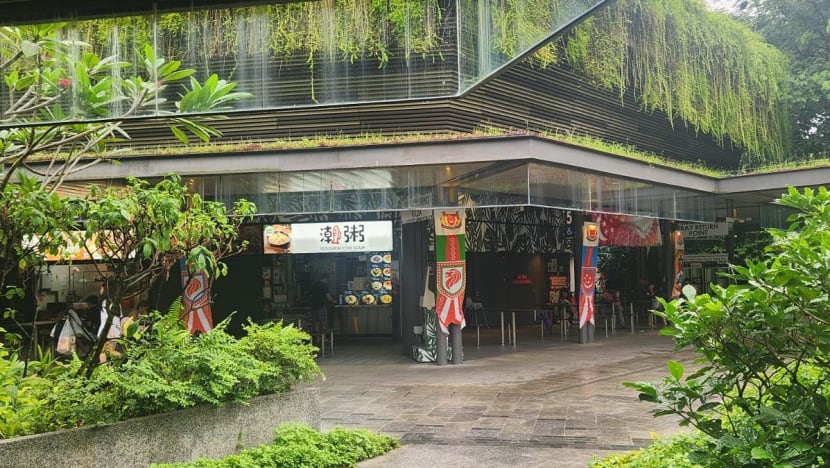Socially conscious hawker centre model balances stallholder needs and operator flexibility: MSE
Bukit Canberra Hawker Centre's pay-it-forward initiative was a “well-intentioned” scheme to support lower-income customers, says Senior Parliamentary Secretary Goh Han Yan.

Bukit Canberra Hawker Centre. (Photo: Facebook/Ong Ye Kung)

This audio is generated by an AI tool.
SINGAPORE: Socially conscious enterprise hawker centres (SEHCs) are designed to balance the interests of stallholders and customers while allowing operators flexibility for their business strategies, said the Ministry of Sustainability and the Environment on Wednesday (Sep 24).
Senior Parliamentary Secretary for Sustainability and the Environment Goh Han Yan addressed questions in parliament about the SEHC model and the government’s role in overseeing tenancy arrangements.
She said that the model was introduced to “harness the experience and expertise" of industry players.
Her comments follow public concern over tenancy agreements at Bukit Canberra Hawker Centre, which included a clause requiring hawkers to provide free meals under a pay-it-forward initiative.
The operator, Canopy Hawkers Group, has since announced it will remove the clause when the hawkers’ tenancy agreements are renewed this month.
MP Louis Chua (WP-Sengkang) asked about the National Environment Agency’s (NEA) involvement in the contracts at SEHCs, and how authorities decide who should bear the cost of providing affordable meals to patrons.
Ms Goh replied that NEA maintains oversight of the operators managing these hawker centres, and they must comply with its requirements.
“These requirements strike a balance between ensuring that patrons’ needs are adequately served and safeguarding stallholders’ well-being,” she said, adding that NEA allows operators “sufficient flexibility” to run the hawker centres effectively.
Since 2018, NEA has set out basic guidelines for tenancy terms, including limits on penalties for contractual breaches. The agreements are reviewed by NEA before stallholders sign them and clauses are adjusted if necessary, said Ms Goh.
CHARITY SCHEME, VALUE MEALS AND DISCOUNTS
On the issue of charitable meal schemes, Ms Goh said that only Bukit Canberra Hawker Centre has such a programme to date. She described its pay-it-forward initiative as a “well-intentioned” effort to support lower-income patrons and make the centre an “inclusive community dining option”.
NEA was informed of the scheme, and stallholders were aware of it before deciding to rent their stalls. This means that tenants who decided to rent their stalls at this hawker centre would have factored these costs into their considerations, she said.
“Notwithstanding this, I understand that the operator has not implemented the scheme to date and following feedback from stallholders and the public, the operator has decided to remove the requirement from new agreements and tenancy renewals.”
As for affordable meal options, Ms Goh said SEHC operators are required under NEA's tender conditions to implement measures to keep food affordable. Most have done so by requiring each stall to offer at least one value meal, while allowing other items to be priced higher.
“Operators will also review their value meal prices from time to time and have previously adjusted prices upwards based on feedback from stallholders,” she added.
“Importantly, stallholders are not expected to make a loss from selling such value meals as they should have taken this into consideration when negotiating the rent with operators.”
MP Foo Cexiang (PAP-Tanjong Pagar) asked whether NEA would review the requirement for stallholders at SEHCs to absorb a 10 per cent discount offered to customers using operators' apps.
Ms Goh said the apps are part of wider efforts to attract footfall. “SEHC operators bear the costs of developing such apps and conducting marketing and publicity efforts, while stallholders bear a portion of the costs by providing discounts in return for increased sales.”
In a supplementary question, Mr Foo asked if all hawkers understood that they are not expected to incur losses from providing value meals.
"I ask because I would expect there to be a wide variation in the practices on the ground, because there are some food types like economy rice where this would be much more easily implementable, as compared to Japanese food, where the base of the food cost is already higher," he added.
In response, Ms Goh stressed that stallholders "walk in with their eyes wide open" about the value meal requirement and how it applies to their operations.
Acknowledging that different stalls may need different approaches to meet this condition, she said price adjustments over time are reasonable due to inflation or other factors.
NEA’s surveys between 2021 and 2024 showed satisfaction levels above 80 per cent for various aspects of SEHC management, with stall occupancy rates at about 96 per cent, said Ms Goh.
Operators must hold quarterly feedback sessions with their tenants, which NEA representatives also attend. These serve as a “regular platform” for hawkers raise concerns.
For example, one operator received feedback about high gas costs and will explore cheaper alternatives after its current gas contract expires, she added.


















